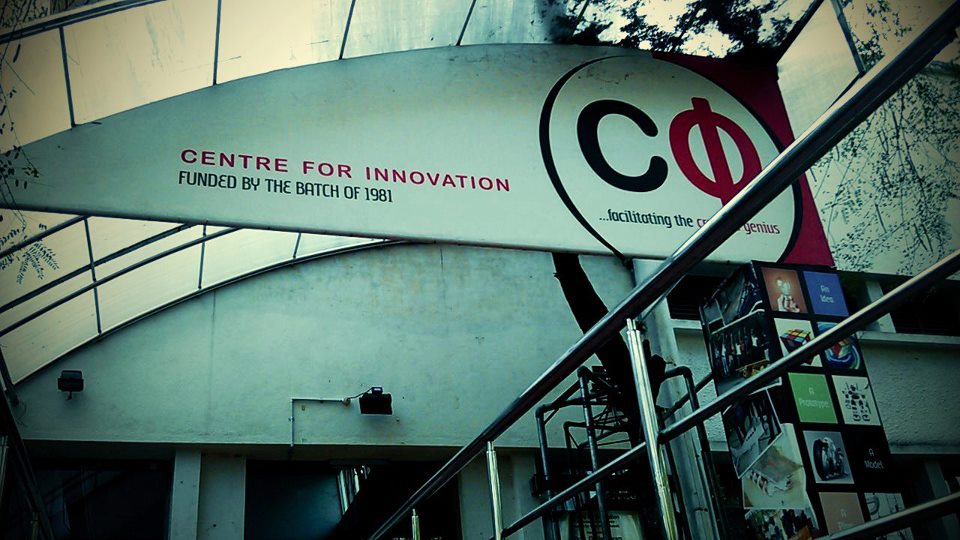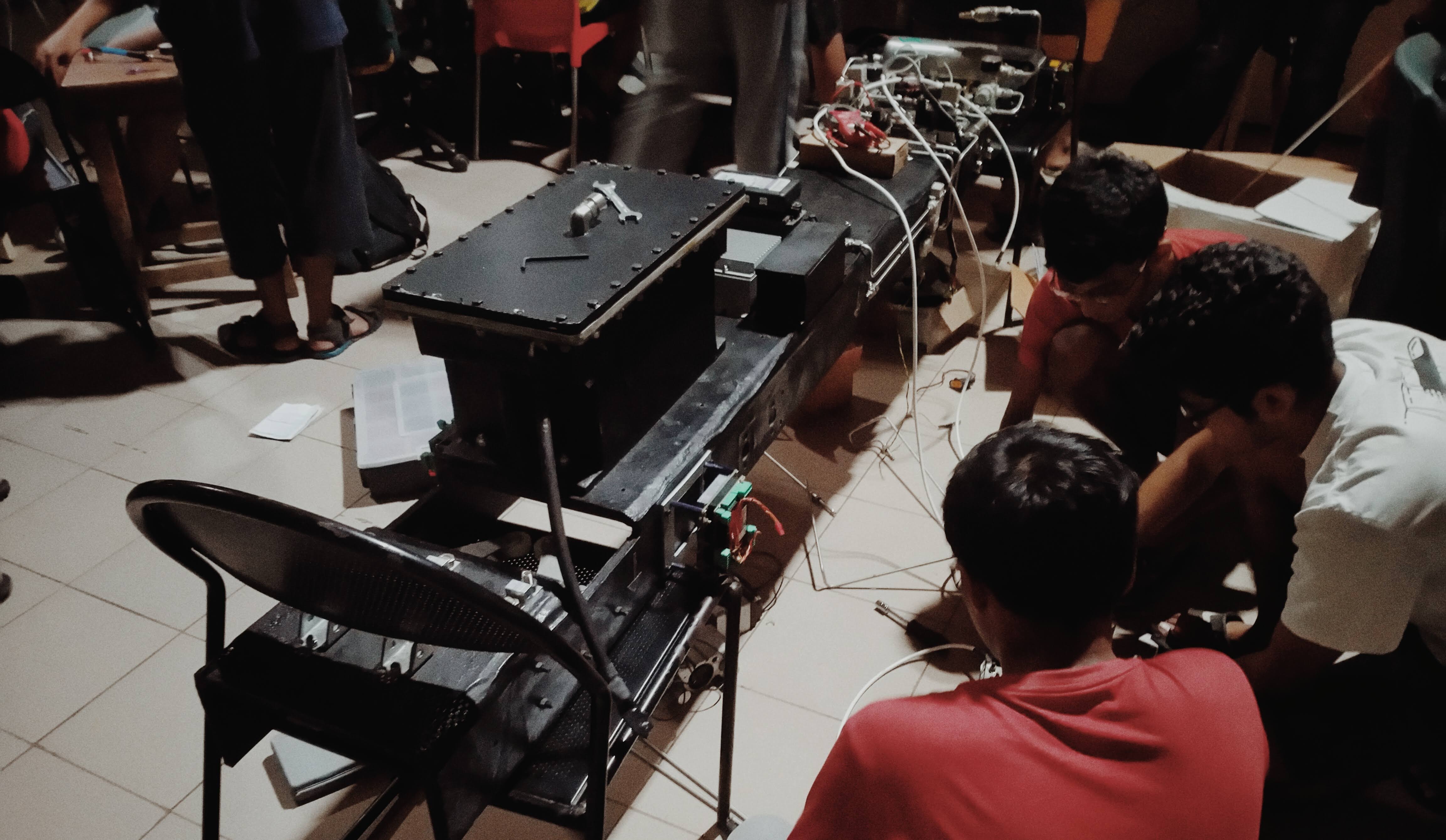The Centre For Innovation, IIT Madras (CFI) is currently one of the largest umbrella organisations for club activities grounded in technology and innovation, among higher educational institutions in India. This article, compiled by Sabarinath R Nair, throws light on the structure, activities, associations, and a few of the numerous significant breakthroughs and achievements that CFI has made in recent years.
When it began, the vision of CFI was to be a platform for budding engineers and entrepreneurs to transform their ideas into products. This is quite plainly reflected in CFI’s motto, “Walk in with an idea, walk out with a product”. Of late, CFI’s focus has expanded to also include impactful projects that are more relevant to the society we live in. The UAV (Unmanned Aerial Vehicle) for Disaster Management project undertaken by the Computer Vision and Intelligence Group in collaboration with the Aero Club is just one such example. The project placed first in the code.fun.do initiative of Microsoft. Team Sahaay (a Team which is specifically meant for such social innovations) has tied up with NGOs to roll out Automatic Waste Segregators. The “Smart Agricopter” – an agricultural drone for spraying pesticides with the feature of weight-carrying ability developed by the Aero Club, the Electro-larynx for differently abled persons, and the Rehabilitation Workbench for paralysed patients built by Team Sahaay are some more of the aforementioned socially relevant ideas implemented under the CFI banner.
The Machinery of CFI
The entirety of CFI has a single CFI Head. When it began with funding from the Class of 1981, it was the Co-Curricular Affairs Secretary that headed CFI. Later, the post of CFI Head was made separate. Currently, the applicants for the post are evaluated and the best is selected by the CFI Faculty Advisor through an interview, after an interview by the ex-Heads as well.
CFI is split into three verticals – Clubs, Competition Teams and Managerial Teams.
Clubs
There are ten Clubs under CFI which take up projects and allocate members accordingly, and they are:
- 3-D Printing Club,
- Aero Club,
- Analytics Club,
- Computer Vision and Intelligence Group (CVIG),
- Electronics Club,
- i-Bot Club,
- Physics and Astronomy Club,
- Programming Club,
- Team Envisage (the Techno-Entertainment Club),
- and Team Sahaay.
It is quite noteworthy that Team Chakravyuh, working on the change of chain-sprocket system in cycles to bevel gears, have already finished a prototype which came 2nd out of almost 500 teams that participated in the national-level Indian Engineering Project Consultancy (IEPC) competition. This project was taken care of by the Project Management team (as this project cannot be placed under one particular club), and they are going to be incubated in the IIT Madras Research Park by this December.
Structure: At the Club level, there are Club Heads (with a cap of 2 for each Club), a Strategist in most Clubs, Coordinators that function under the Heads, and Project Managers for each project taken up by the Club. The role of the Club Heads is to mentor the project, supervise the progress of the work being done and solve abrupt issues that may ail the projects from time to time.
Competition Teams
Some of the most renowned Competition Teams are:
- Team Anveshak (builds Rovers that scale harsh terrain),
- Team Abhiyaan (builds an Intelligent Autonomous Ground Vehicle),
- Team Avishkar (builds a Hyperloop Pod to represent IIT Madras at SpaceX Hyperloop Pod Competition),
- and Team Raftar (the Student Formula Racing Club of IIT Madras).
Some recent achievements of these Teams are exemplary and awe-inspiring.
- Team Abhiyaan’s vehicle named ‘Virat’ came 5th in Auto-Nav, 6th in Design, 2nd in the IOP Challenge and 2nd Overall at the 27th Intelligent Ground Vehicle Challenge (IGVC) 2019 at Oakland University. The team placed 10th in Auto-Nav, 5th in Design, 4th in the Self-Drive Challenge, and 10th Overall in 2018.
- Team Anveshak emerged champions at the Indian Rover Challenge (IRC) 2019. They also recently leaped to the 12th place in the University Rover Challenge 2019 held in Hanksville, Utah. In 2018 and 2017, they came 25nd and 29th respectively.
- Team Avishkar was the only Asian team in the top 47 teams across the world to clear the Preliminary Design Phase of SpaceX Hyperloop Challenge, 2018. They qualified for the final round. Given that it was the debut attempt of Team Avishkar, it is quite an astounding feat. This year, in their second attempt, they also cleared the Final Design Phase and were one of the top 22 teams, making national headlines and garnering celebrity support.
- Team Raftar came 39th in Formula Student Germany this summer at the Hockenheimring circuit in Germany. They placed third out of 71 teams while winning the Fuel Efficiency Event and coming second in Endurance at Formula Bharat 2018 in Coimbatore. In 2019, Raftar emerged as the Overall Static winner, Design Event winner and Cost Event runner-up. They also won a podium in Business Plan Presentation, and the Award for the Cleanest Pit and Most Hospitable Team at the same event. Also, Raftar became the first Indian team to win a dynamic event abroad: at Formula Student 2017, they won the Fuel Efficiency Event.
- Team Amogh who build an Automated Underwater Vehicle were chosen to be incubated by Research Park. They participated in the Underwater Technology Conference, 2015 at NIOT, was ranked in the top 15 out of 39 teams in the 17th International RoboSub Competition at San Diego, USA, and won the National Student’s Autonomous Vehicle Competition (SAVe 2014).
- The Lockheed Martin Team is a University Design Challenge Team who designed a cargo ground build-up system (CGBS) that cuts down operation time from 8 hours to less than 90 minutes. The commercialisation of this CGBS received encouragement from Lockheed Martin, DRDO, and TATA Motors.
Structure: There are Team Heads, Module Leads and Team Members that function under the Heads, in a structure somewhat similar to what the Clubs have. In addition, Competition Teams have Sponsorship Heads who handle matters related to the sponsorship of the Teams by staying in touch with executives.
Competition Teams are different from the Clubs in that most or all of them usually have external sponsors, and generally each Team tends to have multiple sponsors. A few of the popular sponsors are Aditya Birla, MRF, Exide, ASL, GROB, Bosch, GRMC, Fibtec, Cybernetic Technologies, Maxon Motor, and Meridian.
Managerial Teams
The crux of operations of CFI without whom the technical Teams would struggle to execute and expand, the Managerial Teams, are the following:
- The Branding and Engagement (B&E) Team is the face of CFI, formed with a vision to provide better exposure to the students working in CFI. They do this through various events like the Open House, alumni reunions and visits to CFI. The Team also increases the visibility of CFI on social media and websites through content generation, curation and designing.
- The Project Management Team allots Project Managers for Club projects, who ensure that the show for the projects goes on as smoothly as possible by managing inventory, infrastructure, and logistics. They work hand in hand with the B&E Team. This Team also usually takes the reins of charge for projects that cannot be placed under any one Club
- The Finance Team and the Concept & Design (C&D) Team take care of the finances and the design respectively. They are common to CFI and Shaastra, our technical fest.
Structure: For the B&E team there are the two Heads and then the Coordinators. The Project Management Team, notably, has three Heads. The Finance Club has three Heads of whom one is meant specifically for CFI, and they have Super-Coordinators and Coordinators under them.
The Activities and Associations of CFI
CFI conducts a variety of events to inculcate interaction with the general student body, industrialists, alumni, professors, and the world outside them: They conduct the Club sessions wherein they teach beginners (generally the freshies) about topics under their individual purviews, and provide an overview of the Club. These are open to all students. (Notably, the Club sessions conducted by the Programming Club are quite popular among the General Student Body.) They also conduct the Summer Schools during the workshop training period wherein they cover topics in three to four days, setting the attendees off on a steep learning curve. Towards the end, they facilitate the learning process by engaging them in mini-projects. Usually, the Coordinators run this event. The Co-Curricular Sphere Orientation, a collaboration of CFI, E-Cell, Nirmaan, and Shaastra is another event with the presence of interesting prototype workshops and/or stalls.
The Open House conducted at the end of the odd semester (around the beginning of November) is specifically designed to exhibit CFI’s work to the world. Often, professors, alumni, and industrialists visit the CFI Open House and provide their inputs. It serves the dual purpose of gaining CFI public recognition and helping teams to develop their projects through the feedback they receive. Media bodies are commonly invited to this event. Other events that work to inculcate and build interactions are the Inter-IIT Tech Meets, the TechSoc sessions (our article on TechSoc: https://www.t5eiitm.org/ts1010-an-introduction-to-techsoc/) organised by the Project Management team aimed at garnering enthu within the GSB specifically, and the Felicitation Ceremony to hand out certificates to all Project Managers, winners of various competitions, and Team Members.
Nirmaan forms an important cog of doing business in the mammoth machine that is CFI. Nirmaan essentially forms a bridge between CFI and the Incubation Cell. Clubs propose their various projects and initiatives to Nirmaan for funding and those with start-up potential will get funding, workspace and other support from the Incubation Cell.
How New Ideas Take Birth
There are primarily two ways by which CFI incubates ideas for new initiatives/projects. One way is the Student Innovation Programme (SIP) where, around the end of January, CFI opens up a portal for students to submit their project ideas. The Heads and the ex-Heads discuss the feasibility of these ideas, following which CFI takes up the project under a club or a collaboration of clubs. The other way is through the Club-proposed projects wherein the Heads and the ex-Heads themselves propose ideas, usually in consultation with Coordinators and other Team Members. Then, the Heads assign projects to Clubs and Coordinators are allocated to each project. More recently, the CFI management has been showing keen interest in taking up socially relevant projects.
Today, CFI not only fosters a great community of hard-working techies and entrepreneurs who are hell-bent on advancing their projects each year and increasing the scope of ideas taken up; they also maintain an excellent off-Insti community comprising of ex-Heads, alumni, industrialists and other well-wishers who follow up with the work done at CFI and give constant feedback, inputs and ideas for the betterment of the projects and CFI as a whole. On goes the innovating march of the ventures of CFI targeted to create a better world, made possible by the cumulative sagacity of all their well-wishers and supporters.
(This article is based on the interview of Himani B and Sampriti Chattopadhyay, Heads, B&E Team, CFI)
Series by: Akash Reddy




